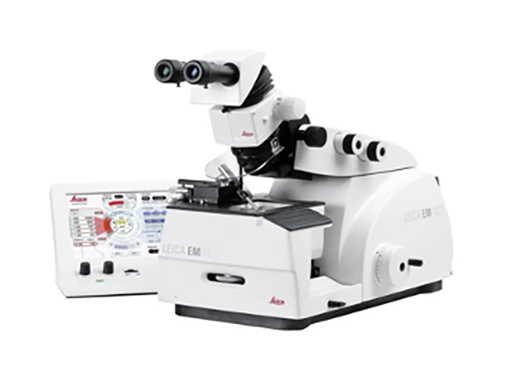We provide Services to all researchers inside and outside of the university.
Researchers from Northwestern University, the University of Chicago and Rush University Medical Center are charged the same internal rates as all UIC users. All other users can access services but at an external academic or external non-academic rate.
List of Services
Materials TEM Service Work
Materials science TEM, STEM service
Focused Ion Beam service
SEM service
Biological TEM and specimen prep service
X-Ray Photon Spectroscopy / Raman service
Instrument Training-Materials science TEM and STEM
Basic TEM Training for new users, with no TEM experience, includes
operational training over a period of 8 hours, in 3 sessions, which must be
completed in a 14-day period. Initial training will use a well characterized
specimen supplied by EMC staff. Later, during the training period project
specific specimens can be used.
Instrument- Focused Ion Beam
Training for Thermo Fisher Helios 5CX FIB
Instrument Training-SEM
Basic SEM Training for new users, with little to no SEM experience,
includes theory and operational training over a period of 4 hours, in 1-2
sessions. Training must be completed in a 30-day period. Training will be
held on the JEOL JSM-IT500HR.
Instrument Training-Bio TEM and specimen prep
Basic bio TEM training will be using JEOL 1400 Flash in west campus.
Instrument Training – XPS & Raman
For XPS or Raman, training is carried out at an hourly charge. For
Raman this will take 1-2 hours, for XPS 2-4 hours.
Instrument Training and service for SEM and TEM specimen preparation:
• Ion mills for both SEM and TEM specimen preparation
• Pt/Pd sputter coater
• Cutting and grinding instruments
• Plasma cleaning
• IR lamp
Pricing
Please check the link below for details of pricing:
EMC Pricing

Life Science TEM Service Work
Life Science TEM Specimen Preparation is a time-consuming procedure. We are able to process up to six pieces of six samples at the same time until we get to the microtomy stage. This results in a significant price break compared to processing each specimen individually. All life science specimens need to be processed to remove the water from the specimen and replace it with a plastic resin without introducing artifacts. Typically, for TEM, this is a multistage process involving: Primary Fixation – to halt degradation of tissue (e.g., 4% glutaraldehyde in phosphate buffer for at least 4 hours). Rate of penetration is slow, and sample must be less than 1mm thick in one dimension to achieve good fixation. Please talk to us for the correct fixative if you want immuno-EM.
Life Science TEM
Life Science TEM
- Washing – in phosphate buffer to remove glutaraldehyde.
- Secondary Fixation – to stabilize cell components (e.g.,1% Osmium Tetroxide in phosphate buffer)
- Dehydration – to replace water with ethanol (increasing ethanol concentrations from 50% to 100% in 5 steps)
- Infiltration – to replace ethanol with a transitional solvent (e.g., Propylene oxide) then replace the transitional solvent in the specimen with resin (33% resin in propylene oxide increasing in 4 steps to 100% resin.) Typical resins used include LR White and LX112.
- Embedding – to enclose the resin impregnated specimen in resin block.
- Curing – leave the blocks for a period of time (24hours at 60oC) to set.
- Thick sectioning – Use the microtome to cut thick sections which are then stained in toluidine blue for optical examination to confirm area of interest is present.
- Ultramicrotomy – to cut transmission thin slices from the resin block containing the specimen and deposit the slices onto a support grid.
- Staining – to increase the contrast of the images obtained by staining parts of the structure with a heavy metal stain (e.g., uranyl acetate – a nuclear stain or lead citrate – a cytoplasmic stain)
Step 1 Primary fixation should be done in the investigator’s lab as soon as the sample is harvested to avoid degradation of the sample. EMS staff will NOT accept unfixed specimens. Tissue samples should be no larger than 5-10mm and no thicker than 1mm. The volume of the fixative should be at least four times that of the sample.
Steps 2 to 7 are carried out by EMS staff in the EMS-W prep lab (E5B MSB). We are able to process up to six pieces of six samples in each run which can take anywhere up to 12 hours of staff time depending on type of sample (e.g., cell culture versus tissue sample) and specific protocol requirements. This will typically be completed over a two-to-three-day period. At the end of the run each piece of each sample is embedded in a resin block suitable for microtomy. You will be charged for the actual staff time used for each run which will not exceed $756 (12 hours).
Step 8 thick sectioning takes around 20 min per block and step 9 Ultramicrotomy takes around 40 min per block generating up to 6 grids from each block. You will be charged for the actual staff time used which will not exceed $63.00 per block sectioned.
Step 10 Staining takes 1 hour for up to six grids and typically two grids from each block sectioned are stained. You will be charged $63.00 for each Staining run.